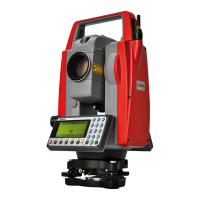84
12.5 Vertical 0 point error
Make sure to follow check procedures mentioned below after making adjustments on reticle
and perpendicularity of line of sight to horizontal axis.
[Checks]
① Set up the instrument and turn the power on.
② Sight the telescope at any reference target A at Normal state. Read the vertical angle (y).
③ Turn the telescope and rotate the alidade. Sight the same target A again at Back state and
read the vertical angle R.
If y+R = 360°, no further adjustment is necessary.
[Adjustments]
If the deviation d (y+ R - 360° ) is wide, contact your local dealer.
12.6 Laser plummet
[Checks]
① Set the instrument on the tripod, and place a piece of white
paper with a cross drawn on it right under the instrument.
② Press the [LASER/Camera] key and press [F1] [LASER]
key and press [F4] [PLUM.ADJ] key , and move the paper
so that the intersecting point of the cross comes to the
centre of the laser mark.
③ Rotate the instrument around the vertical axis, and observe
the centre mark position against the intersecting point of
the cross at each 90° rotation.
④ If the laser mark always coincides with the intersecting
point, no adjustment is necessary.
[Adjustments]
When a centre part where a cross intersection and the laser mark look the brightest shifts by
0.5mm or more (at the instrument height 1.5m), it is necessary to adjust it.
A repair engineer does this adjustment. Please contact the PENTAX dealer.
12.7 Offset constant
The offset constant rarely changes. It is recommended, however, that check be done once or
twice a year.
The check of the offset constant can be done on a certified base line. It can also be obtained in
a simple way as described below.

